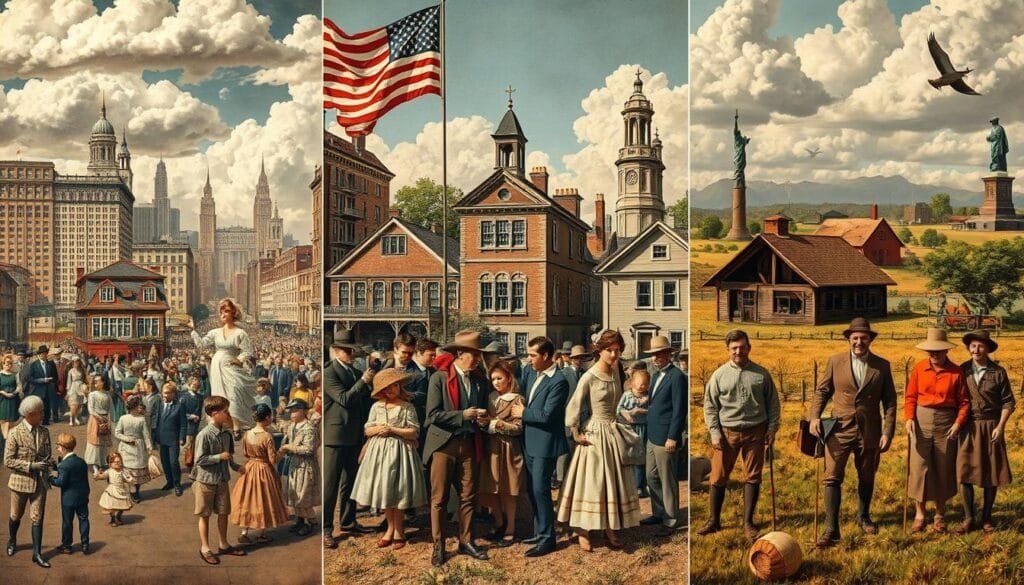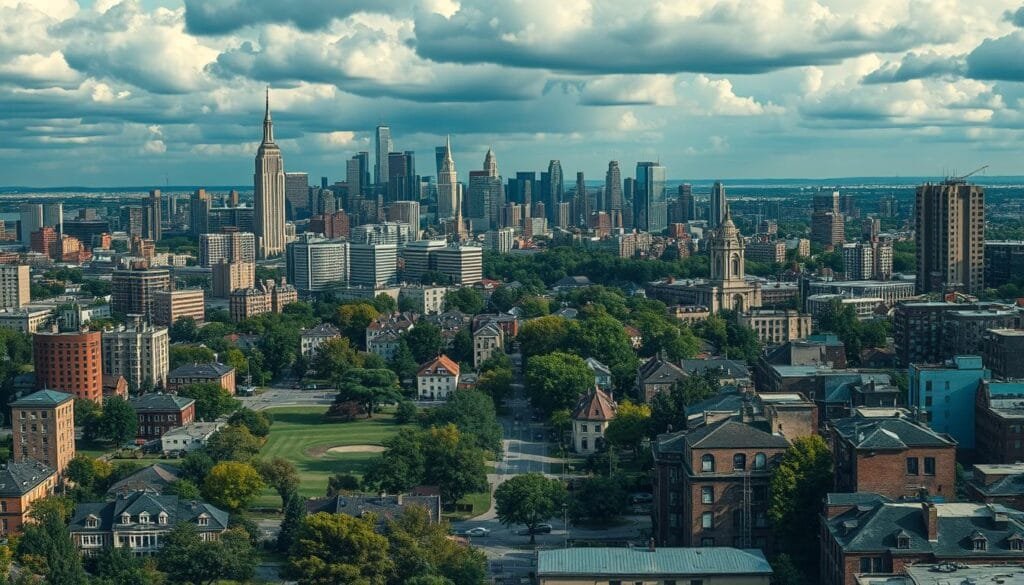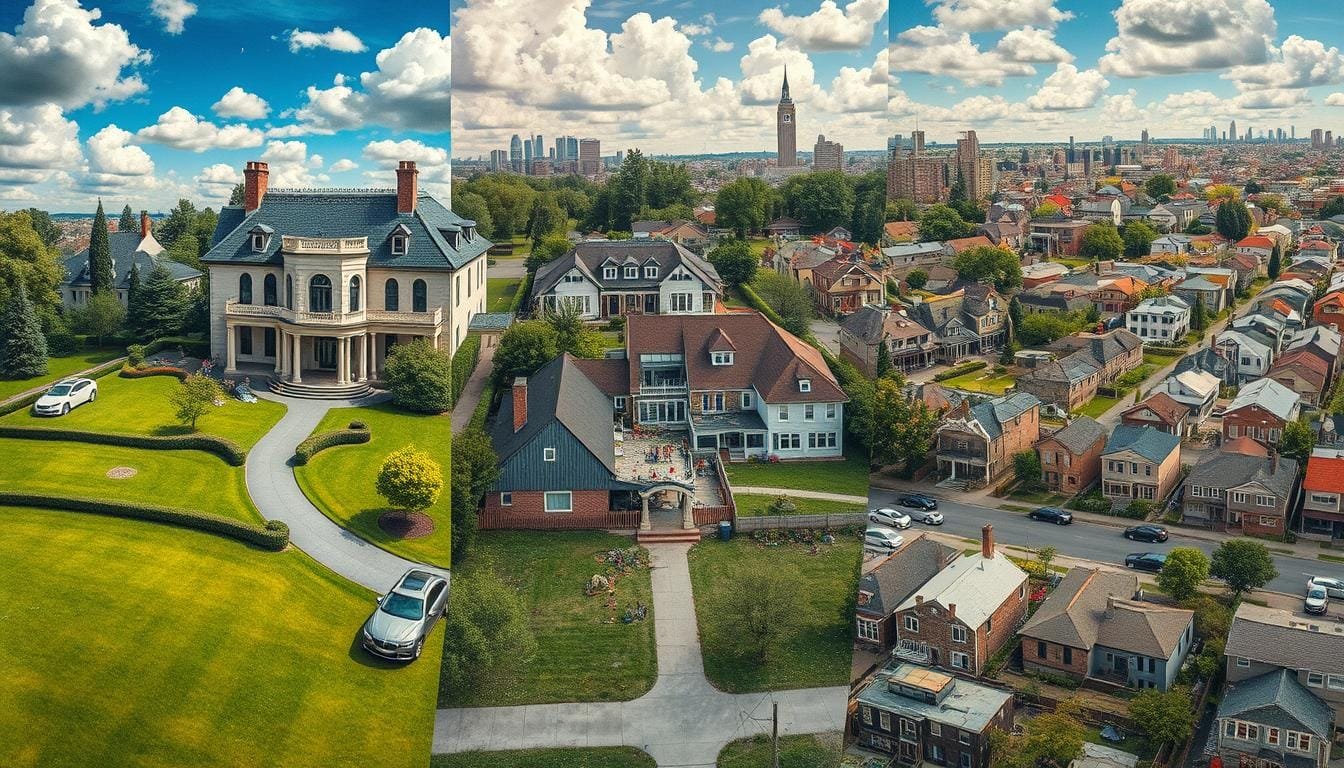In America, society is split into three main groups: the upper, middle, and lower classes. Each group has its own unique traits. These include how much money people make, their education, how they live, and what they have access to. Understanding these classes helps us get why America works the way it does.
Émile Durkheim talked about how everything in society needs to connect, especially for social unity and togetherness. He believed that being different economically and socially lets people live together calmly in today’s world. This idea is called organic solidarity. On the other side, Karl Marx saw society’s economy as its foundation. He thought the battles between classes were what made societies change and grow.
The middle class has seen a lot of changes over time. Back in 1970, they had 62% of all the money, but by 2014, this dropped to 43%. By 2021, half of Americans were considered middle class. This shows how their place in society has shifted. Also, the richest 1% owned 21% of all money, pointing to big differences in income.
Key Takeaways
- US social classes consist of the upper class, middle class, and lower class.
- Class structure in America includes income levels, education, lifestyle, and resources.
- Durkheim emphasized social integration and organic solidarity in societies.
- Marx focused on class conflict as a driver for social change.
- The middle class’s income share decreased significantly from 1970 to 2014.
Introduction to Social Stratification in the US
In America, social stratification is a system that ranks people by wealth, education, job, and power. It helps us understand the US class system and the economic inequality it creates. This inequality affects many Americans’ lives every day.
The top 1 percent of Americans, known as the upper class, holds one-third of the nation’s wealth. Their wealth has a huge impact on society. It shapes both economic outcomes and social views about what is prestigious.
America’s social classes can be split into three main levels: upper, middle, and lower. The top 20 percent of earners are in the upper-income group. The next 60 percent are the middle class. The bottom 20 percent are considered lower-income.
The differences between these classes show up in their education and jobs. People in the upper-middle-class usually have advanced degrees. They work in respected jobs like doctors (prestige score: 86) and college teachers (prestige score: 74).
Those in the lower-middle-class might have four-year college degrees or two-year degrees. They have stable jobs like elementary school teachers (prestige score: 64) and mail carriers (prestige score: 47).
The lower class includes blue-collar workers and the working poor. Blue-collar workers do jobs in factories and on construction sites. The working poor have unskilled jobs that don’t pay much. For example, garbage collectors (prestige score: 28) and janitors (prestige score: 22) have jobs that offer little prestige. Despite having jobs, many earn less than the poverty line. This highlights the huge economic inequality.
Social stratification in America is not just about how much money people make. It’s also linked to their education and job prestige. These factors affect how society sees people and the opportunities available to them.
| Class | Income Range (Annual) | Typical Education | Occupations | Prestige Score |
|---|---|---|---|---|
| Upper Class | Above $145,500 | Postgraduate Degrees | Physician, CEO | 86 |
| Upper-Middle Class | $48,500 – $145,500 | Bachelor’s/Postgraduate Degrees | College Professor, Engineer | 74 |
| Lower-Middle Class | $48,500 – $145,500 | Bachelor’s/Associate Degrees | Elementary School Teacher, Letter Carrier | 64, 47 |
| Working Class | Below $48,500 | High School Diploma | Factory Worker, Construction Worker | Varies |
| Working Poor | Below Poverty Line | High School/Some College | Garbage Collector, Janitor | 28, 22 |
Historical Context of Social Classes in the United States
The idea of social classes in the US has changed a lot over time. It’s been shaped by big changes in economy, politics, and society. From the early days in the colonies to now, big events and changes have influenced social classes. This includes the start of factories and different economic policies.
The Colonial Period
In the colonial time, social classes were shaped by European traditions and things happening locally. In New England, society was more equal with no real upper class. But, rich merchants rose in cities like Boston and Salem. In the Southern Colonies, wealthy landowners like George Washington and Thomas Jefferson pushed for change. They supported the American Revolution. This helped make a society where people could move up in the world by owning land and getting involved in politics. Farmers in the Old South also mattered a lot, helping the economy.
Industrialization and the Rise of the Middle Class
From the 1830s to the 1920s, factories, railroads, and banks changed society in the Northeast. This created new wealth and chances for people to improve their lives. By 1858, industrial leaders had started ten resources for networking and advancing their interests. Places like the Philadelphia Club and Cooper Union helped. They supported tech education and allowed people to move up based on merit, helping the middle class grow. Yet, workers lived in specific areas and faced challenges, especially during tough times like the Panic of 1819.

The Modern Era
In recent times, social classes have changed due to economic and technological progress. The 20th and 21st centuries brought more income and wealth. This was thanks to American inventions and science. But, not everyone benefitted equally. The gap between rich and poor got bigger. This made some worry about whether people can still move up in society. Education became even more important in deciding someone’s social standing. Sadly, people from poorer backgrounds face more health problems and have less healthcare. Even so, things like income, wealth, and education play a big role in one’s health and life quality.
What Are the 3 Classes of US Society
In the United States, understanding the three main social classes is key. These groups are upper, middle, and lower class. Factors like how much you earn, your job, and your schooling define each class.

In 2022, data showed 52% of adults were middle-income, while 28% were lower-income. Only 19% were upper-income. This info is crucial for understanding different classes and how they live.
The middle class makes up more than half of Americans. They earn between about $56,600 to $169,800 per year for a three-person family. But this can change depending on where you live. For example, in San Francisco, you need around $66,700 to be middle class. But in Jackson, Tennessee, you only need about $49,200.
There’s a big difference in income and class depending on where you are in the US. For instance, the middle class makes up 42% in San Jose, California but goes up to 66% in Olympia, Washington. Lower-income groups range from 16% in North Dakota to 46% in Texas. The smallest upper-income group is 8% in Michigan, and the largest is 41% in California.
Here’s a table that breaks down the US social classes:
| Social Class | Income Range (Annual) | Occupational Types | Education Level |
|---|---|---|---|
| Upper Class | Above $200,000 | Executives, Entrepreneurs | Advanced Degrees |
| Middle Class | $56,600 – $169,800 | Professionals, Managers | College Graduates |
| Lower Class | Below $56,600 | Service Workers, Laborers | High School Diploma |
Looking at socioeconomic class data, the middle class changes a lot by place. For instance, in Scottsdale, Arizona, you need about $99,097 to live a middle-class life. But, this number varies in different cities.
Understanding these class divisions helps us see how income affects life in the US. It shows us a complex but organized society. Where you fall can affect your chances for a better life.
Characteristics of the Upper Class
The upper class in the United States has a lot of wealth and leads exceptional lives. They also have big political influence. This group is made up of people and families who own a lot of the nation’s wealth. They are just a small part of the population.
Old Money vs. New Money
When talking about the upper class, we often hear about “Old Money” and “New Money.” “Old Money” families have wealth that has been in their families for generations. The Vanderbilts and the Rockefellers are examples of this. They show stability and have been in American society for a long time.
“New Money,” on the other hand, is about people or families who made their fortune recently. Examples include tech giants like Elon Musk and Mark Zuckerberg. They often live and act differently than the “Old Money” crowd. This shows how they’ve recently become rich.
Economic and Political Influence
Wealthy Americans greatly affect the economy and politics because of their money. A study by the Pew Research Center in 2018 found that 19% of Americans were part of upper-class households. In 2016, these families earned a median income of $187,872. They own a huge part of the country’s wealth.

The table below shows how the upper class has more economic power than other classes in the United States:
| Class | Percentage of U.S. Population | Median Income (2016) |
|---|---|---|
| Upper Class | 19% | $187,872 |
| Middle Class | 52% | $78,442 |
| Lower Class | 29% | $24,817 |
Rich Americans also have a lot of political power. They often donate to political campaigns, push for laws that help them, and get important jobs in the government. They use their money to influence policies and opinions.
The upper class runs important parts of the economy. They use their wealth to keep their power in American society.
Understanding the Middle Class
The middle class is the United States’ largest and most varied economic group. It includes a wide range of incomes, jobs, and ways of life. We split the middle class into two main groups: the upper-middle class and the lower-middle class. We look at how education, work, and money differ between them.
Upper-Middle Class
The upper-middle class stands out for its higher education and professional jobs. This group usually has advanced degrees. They work in law, medicine, or academia. Usually, they make between $100,000 and $150,000 a year.
These middle-income Americans often own homes, can access good healthcare, and save money. They save for retirement and their kids’ schooling. They spend a lot on their children’s private schooling and activities. This helps their children develop mentally and socially.
Lower-Middle Class
The lower-middle class also values education but usually has less-paid and less-prestigious jobs. Their annual pay ranges from $30,000 to $75,000. This group has jobs like clerical work, administration, and technical support.
Even though it’s harder for them to have a middle-class life, they value job stability. Their goal is to steadily improve in their careers. When it comes to raising kids, this class focuses on meeting basic needs. They may not be as involved as the upper-middle class in their children’s activities.
| Category | Upper-Middle Class | Lower-Middle Class |
|---|---|---|
| Annual Income | $100,000 – $150,000 | $30,000 – $75,000 |
| Education | Postgraduate Degrees | College Degrees |
| Occupations | Professional Jobs (e.g., Doctors, Lawyers, Professors) | Clerical, Administrative, Technical Jobs |
| Child-Rearing Practices | Concerted Cultivation | Providing Basic Necessities |
The Working Class and Lower Class
The working class and lower class play a big role in American society. They add a lot to our social and economic world. They face special challenges that come from their money, education, and jobs.
Working Class Characteristics
Around 30% of the U.S. is working class, making $19,000 to $45,000 annually. These folks often work in physical jobs, have limited education, and focus on job security and health care.
After World War II, many moved up to the middle class. This showed that people could improve their living standards. Today, they often face job ups and downs and need help like food stamps. The use of SNAP went up to 40 million during the hard times of the Great Recession.
The Lower Class and Poverty
About 27% of Americans are in the lower class, highlighting poverty in our nation. It’s made up of the working poor (13%) and the underclass (14%). They deal with joblessness and a lot of reliance on government aid.
The gap between rich and poor is big. One percent owns a third of the wealth while the bottom 80% has just 11%. Even with welfare reform, poverty numbers did not drop, showing ongoing economic struggles.
For a deeper look at social levels and moving up in the U.S., including experiences of all classes, check out Lumen Learning’s comprehensive resource.
Sociological Theories on Social Class
To understand social class, we look at different sociological views. Two main ones are functionalism and conflict theory. Each sees social class in its own way.
Functionalist Perspective
Functionalist theories see social classes as key to society’s stability. Scholars like Emile Durkheim think social layers make sure important jobs get to the right people. They believe people are paid for their contribution to society, leading to efficiency.
Functionalsim explains why we have different social classes. It says the US’s system of capitalists, middle, and working classes keeps order. The idea is that every class plays a unique and necessary role.
Conflict Perspective
On the other hand, conflict theory, started by Karl Marx, points out flaws. It says the system favors the rich over the poor and workers. It’s all about who has more money and power, they suggest.
It views the US class layout as a source of inequality and blocked chances to move up. According to this theory, workers face hard times due to lost unions and safeguards. It also talks about how poor people stay poor.
Both functionalism and conflict theory shed light on social class. Functionalism looks at the roles and stability within society. Whereas, conflict theory focuses on power imbalances and inequality. Knowing these theories helps us grasp the complexities of social classes.
Conclusion
We’ve learned the US has deep economic divides and moving up socially is hard. History shows us how old and strong these divides are. By looking at the upper, middle, and working classes, we see how different each group is. This affects people’s chances in life, their wealth, and political strength.
Looking into sociology, Max Weber and Karl Marx help us see how class, status, and power mix. Weber talks about class, status, and power in different ways. Marx focuses on the conflict between the bourgeoisie and the proletariat. Their ideas help us see how class affects everyone, pushing us to think about fairness and policy.
When we think about moving up in the US, the idea of meritocracy is tricky. It suggests hard work leads to success, but it’s not always true. Recognizing the real barriers is key. We need to look at policies and push for fairness. Understanding these class divisions helps us work toward a more equal society.
FAQ
What are the primary social classes in the United States?
In the United States, there are three main social classes. These are the upper class, the middle class, and the lower class. The differences between these classes include how much money people make, their education, lifestyle, and what resources they can access.
What factors contribute to social stratification in the US?
Wealth, education, jobs, and power heavily influence social stratification in the US. These factors divide society into different social layers. This division leads to economic inequality among people.
How has the class system in the United States evolved over time?
The US class system has changed a lot from the colonial times to today. Industrialization helped grow the middle class. It also changed how people move between classes. Economic policies and important historical events have also shaped how we view and experience class.
What are the criteria used to distinguish social classes in the US?
To tell social classes apart in the US, we look at how much money people make, their jobs, and education. These things greatly affect a person’s lifestyle and the chances they have in life.
What defines the upper class in the US?
The upper class in the US is known for its big wealth. This wealth can be inherited or earned in a person’s lifetime. People in this class often have a strong influence on politics and the economy.
How is the middle class in the US categorized?
The US middle class is split into two parts: the upper-middle class and the lower-middle class. The main differences between these groups are in education, job types, and income. These factors also affect their way of life and what they can achieve.
What are the characteristics of the working class and lower class?
The working and lower classes in the US have lower income and job security. They also have less access to healthcare and education. People in these classes often struggle with poverty and other economic problems.
What are the functionalist and conflict perspectives on social class?
From a functionalist view, social stratification helps keep society organized. It makes sure the most capable people fill the most important roles. However, the conflict perspective believes social class lets those in power stay in control. It helps them keep economic differences in place.
